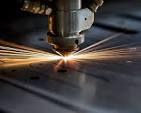Laser Cutting: The Ultimate Guide to Precision Cutting Technology
- shiva ganesh
- Jul 28
- 4 min read
Table Of Content
Introduction to Laser Cutting

What is Laser Cutting?
Laser Cutting is a precise and highly efficient thermal cutting process that uses a focused beam of high-powered laser light to melt, burn, or vaporize material along a programmed path. It is widely used for producing complex shapes, fine details, and clean edges in sheet materials such as metals, plastics, wood, and composites.
Laser cutting is essential in industries requiring precision, speed, and repeatability, such as automotive, aerospace, electronics, signage, medical devices, and architecture.
A Brief History of Laser Cutting
Laser cutting technology emerged in the 1960s with early applications in aerospace for cutting hard materials like diamond. By the 1980s, it became commercially viable for metal fabrication and manufacturing. Today, fiber lasers and CO₂ lasers dominate the industry due to their precision and adaptability.
How Laser Cutting Works

The Basic Workflow
Design the part using CAD software.
Convert the design into machine-readable G-code via CAM software.
Load the material sheet onto the laser bed.
Focus the laser beam on the material.
Execute the cutting process following precise toolpaths.
Inspect for dimensional accuracy and edge quality.
Key Components of a Laser Cutter

Laser Source
Generates the laser beam. Common types:
CO₂ Lasers (best for non-metals, some metals)
Fiber Lasers (best for metals)
Optics and Focusing Lens
Directs and focuses the beam to achieve a small, high-energy spot.
Cutting Head
Contains the lens and nozzle, controlling gas flow and distance to the material.
Assist Gas System
Blows oxygen, nitrogen, or air through the cut to improve quality and remove debris.
Controller
Processes G-code to control the laser path, power, and speed.
Laser Cutting Processes
Fusion Cutting
Melts the material and uses gas (often nitrogen) to blow molten material away.
Flame Cutting
Uses oxygen to ignite the material, assisting in cutting thicker metals.
Sublimation Cutting
Directly vaporizes material, common in plastics and foams.
Precision Engraving
Low-power setting for marking, engraving, and etching designs onto surfaces.
Materials Used in Laser Cutting
Common Materials

Metals
Steel, stainless steel, aluminum, brass, copper, titanium.
Plastics
Acrylic, polycarbonate, ABS, PETG, PVC (with caution).
Wood
Plywood, MDF, hardwood.
Composites
Carbon fiber sheets, fiberglass.
Others
Paper, cardboard, leather, fabrics.
Applications of Laser Cutting

Automotive
Chassis components, brackets, trim parts.
Aerospace
Precision panels, structural elements, engine components.
Electronics
Enclosures, heat sinks, shielding components.
Signage
Letters, logos, decorative panels.
Medical Devices
Surgical tools, implants, housings.
Architecture
Screens, cladding, decorative features.
Advantages of Laser Cutting
Precision and Accuracy
Achieves tolerances as fine as ±0.05mm with smooth, clean edges.
Speed and Efficiency
High cutting speeds, especially for thin materials.
Non-Contact Process
No physical tool wear, reducing maintenance and contamination risks.
Versatility
Cuts a wide range of materials and thicknesses with minimal setup.
Minimal Waste
Nesting software optimizes material usage.
Limitations of Laser Cutting
Thickness Limitations
Typically effective up to 20-25mm for metals; thicker materials require slower speeds or other methods.
Heat-Affected Zone (HAZ)
May cause discoloration or minor warping near the cut edges, especially in metals.
Reflective Materials
Materials like copper and brass require special lasers (fiber) and careful setup.
Operational Costs
Energy consumption and gas usage can be significant.
Laser Cutting vs. Other Cutting Methods
Key Differences
Feature | Laser Cutting | Plasma Cutting | Waterjet Cutting | CNC Routing |
Precision | High (±0.05mm) | Moderate | Very High | Moderate |
Edge Finish | Smooth | Rougher | Excellent | Depends on material |
Material Range | Metals, non-metals | Metals only | Most materials | Non-ferrous |
Speed | Fast | Very fast (thick) | Slow to moderate | Fast |
Cost | Moderate to high | Lower | Higher | Moderate |
When to Choose Laser Cutting
For intricate designs, clean edges, and tight tolerances.
When speed and precision are priorities.
Suitable for small batches to mass production.
Future Trends in Laser Cutting

Fiber Laser Advancements
Increasing power, efficiency, and cutting speeds for metals.
Automation
Robotic loading, unloading, and smart sorting for increased productivity.
AI Optimization
Software optimizing nesting, energy use, and toolpaths.
Hybrid Machines
Combining laser cutting, engraving, and bending in one system.
Cost Considerations
Machine Cost
Small units: ₹20 lakhs – ₹50 lakhs
Industrial fiber lasers: ₹60 lakhs – ₹3 crores+
Operational Costs
Assist gases: Nitrogen, oxygen, air.
Maintenance: Optics, filters, cooling systems.
Energy: Significant for high-power lasers.
Part Cost
Depends on material, thickness, geometry, and volume.
Choosing the Right Laser Cutting Machine
Based on Material
CO₂: Plastics, wood, non-metals.
Fiber: Metals (steel, aluminum, copper, etc.).
Based on Application
Signage: CO₂.
Metal fabrication: Fiber.
Electronics, medical devices: Precision fiber laser.
Volume Consideration
Low to medium volume: Flexible CO₂ or fiber.
High volume: Fully automated fiber laser systems.
Tips for Getting Started with Laser Cutting
Understand Material Behavior
Different materials react uniquely to heat; optimize parameters accordingly.
Use Quality Software
Efficient nesting and accurate toolpath generation reduce waste and errors.
Invest in Maintenance
Regular cleaning and calibration ensure consistent quality and machine longevity.
Prioritize Safety
Ensure proper ventilation, fume extraction, and eye protection.
Conclusion

Laser Cutting is a cornerstone of modern manufacturing, offering unmatched precision, speed, and versatility for a vast range of materials and industries. Whether for prototyping or mass production, fiber or CO₂ technology, laser cutting delivers clean, accurate results every time.




Comments